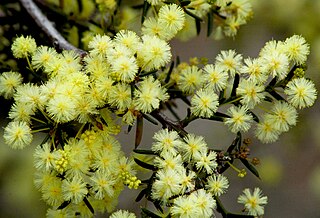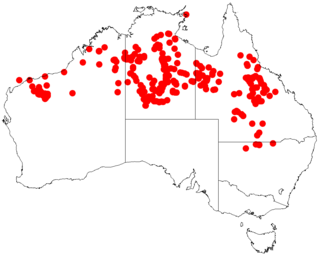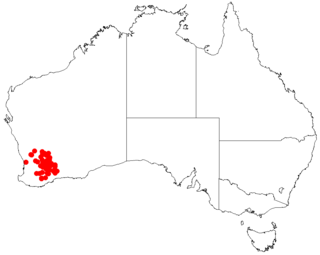
Acacia pycnantha, most commonly known as the golden wattle, is a tree of the family Fabaceae. It grows to a height of 8 metres and has phyllodes instead of true leaves. The profuse fragrant, golden flowers appear in late winter and spring, followed by long seed pods. Explorer Thomas Mitchell collected the type specimen, from which George Bentham wrote the species description in 1842. The species is native to southeastern Australia as an understorey plant in eucalyptus forest. Plants are cross-pollinated by several species of honeyeater and thornbill, which visit nectaries on the phyllodes and brush against flowers, transferring pollen between them.

Acacia pulchella, commonly known as prickly moses or western prickly moses, is a shrub in the family Fabaceae. Endemic to Western Australia, it is one of the most common shrubs of the bushland around Perth and in the Darling Range.

Acacia implexa, commonly known as lightwood or hickory wattle, is a fast-growing Australian tree, the timber of which is used for furniture making. The wood is prized for its finish and strength. The foliage was used to make pulp and dye cloth.

Acacia longifolia is a species of Acacia native to southeastern Australia, from the extreme southeast of Queensland, eastern New South Wales, eastern and southern Victoria, southeastern South Australia, and Tasmania. Common names for it include long-leaved wattle, acacia trinervis, aroma doble, golden wattle, coast wattle, sallow wattle and Sydney golden wattle. It is not listed as being a threatened species, and is considered invasive in Portugal, New Zealand and South Africa. In the southern region of Western Australia, it has become naturalised and has been classed as a weed due to its out-competing indigenous species. It is a tree that grows very quickly, reaching 7–10 m in five to six years.

Acacia enterocarpa, commonly known as jumping jack wattle, is a shrub species that is endemic to eastern Australia.

Acacia stenophylla, commonly referred to as the shoestring acacia, is an evergreen tree in the family Fabaceae and native to Australia. It is not considered rare or endangered.

Acacia verticillata is a perennial shrub to small tree native to south eastern Australia.

Acacia genistifolia, commonly known as spreading wattle or early wattle is a species of Acacia in the family Fabaceae that is native to south eastern Australia.

Gahnia grandis is a tussock-forming perennial plant found in southeastern mainland Australia and Tasmania.

Acacia gunnii, commonly known as ploughshare wattle or dog's tooth wattle, is a woody shrub which is endemic to south-eastern Australia found in dry heaths and woodlands. It ranges from Queensland, then New South Wales, Australian Capital Territory, Victoria, South Australia, down to Tasmania. Acacia gunnii grows to up to 1 metre high and has prickly phyllodes which are 4 to 15 mm long. The cream to pale yellow globular flowerheads appear singly in the axils of the phyllodes in June to October, followed by curved or coiled seed pods which are 40 mm long and 4 to 5 mm wide. Acacia gunnii grows up to 1 meter tall and has prickly phyllodes which are 4 to 15mm in length with cream to pale-yellow globular flower heads appearing in phyllode axils in June through to October, followed by curved or coiled seed pods which are 40mm long and 4 to 5 mm wide. The species was first formally described by English botanist George Bentham in the London Journal of Botany in 1842. It occurs in South Australia, Victoria, Tasmania, New South Wales, Australian Capital Territory, and Queensland.

Acacia cowleana, Halls Creek wattle, is a northern Australian native shrub. It is a flowering plant with yellow flowers that only open in winter. Its origin is the Northern Australia's dry tropics. It belongs to the genus of Acacia.

Agastachys odorata, commonly known as the white waratah or fragrant candlebush, is the sole member of the genus Agastachys in the protea family. It is an evergreen shrub to small tree and is endemic to the heaths and buttongrass sedgelands of western Tasmania.

Acacia burkittii is a species of wattle endemic to Western Australia, South Australia and western New South Wales, where it is found in arid zones, and is a perennial shrub in the family Fabaceae. Common names for it include Burkitt's wattle, fine leaf jam, gunderbluey, pin bush and sandhill wattle. It has also been introduced into India. Previously this species was referred to as Acacia acuminata subsp. burkittii, but is now considered to be a separate species. It grows in mallee, eucalypt and mulga woodland or shrubland, often on sandhills.

Acacia acutata is a species of flowering plant in the family Fabaceae and is endemic to the south-west of Western Australia. It is an inticately branched, often compact shrub with spiny branchlets, sharply pointed, triangular to trowel-shaped phyllodes, flowers arranged in spherical heads of 11 to 15 flowers, and firmly papery pods, rounded over the seeds.

Acacia ulicifolia, commonly known as prickly Moses or juniper wattle is a shrub of the genus Acacia and the subgenus Phyllodineae, native to Australia.

Acacia glandulicarpa, commonly known as the hairy-pod wattle, is a perennial shrub belonging to the genus Acacia and the subgenus Phyllodinea that is native to parts of south eastern Australia.

Acacia leptostachya, commonly known as Townsville wattle or slender wattle, is a shrub or small tree belonging to the genus Acacia and the subgenus Juliflorae that is native to north eastern Australia.

Acacia latzii, also known as Latz's wattle and Tjilpi wattle, is a shrubby tree of the genus Acacia. It is native to the Finke bioregion.
Monotoca glauca, known as goldy wood, is a heath family shrub endemic to Tasmania, Australia and is one of 17 described Monotoca species. It is a widespread and abundant understory species found on the margins of wet eucalypt forests and logged areas.

Olearia ledifolia, commonly known as rock daisy bush, is a species of flowering plant of the family Asteraceae. It is endemic to Tasmania and found at higher altitudes where it grows as a low, compact bush with tough, leathery leaves and small white and yellow daisy-like "flowers" in summer.




















